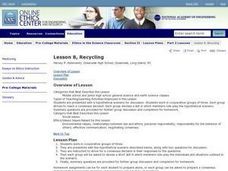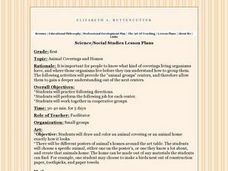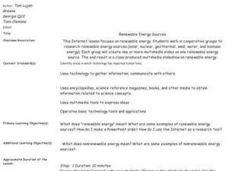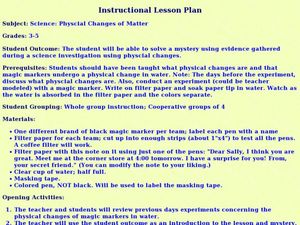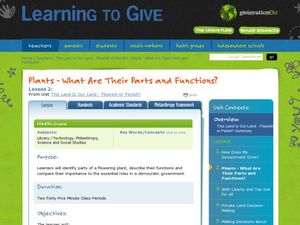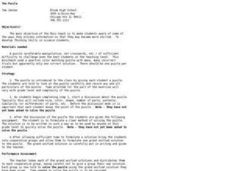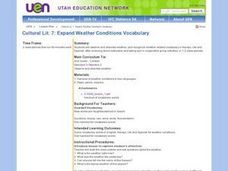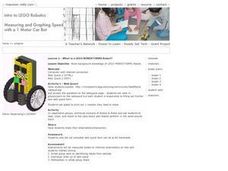Curated OER
Flower Reproduction
Fifth graders examine the cycle of flower reproduction. They listen to a poem about a bee, observe and examine flowers in small groups, and develop a class KWL chart. Students then read about flower reproduction in their textbook, and...
Curated OER
Clustering
Fifth graders are introduced to the concept of clustering. In groups, they use their new science vocabulary words to put into a web or cluster. To end the lesson plan, they read a book related to electricity and write the definitions of...
Curated OER
The Polymer Schoolhouse
Students study various objects and determine plastic and non-plastic. For this creative lesson students get into groups and create a diorama to show the different properties they discovered.
Curated OER
Lesson 8, Recycling
Students examine recycling. In this environmental stewardship lesson plan, students practice persuading others to recycle as they collaborate to prepare small group skits. Students discuss the issue and write reflections about the...
Alabama Learning Exchange
It's a Small, Small World
Middle schoolers compare and contrast the different characteristics of animal-like, plant-like, and fungus-like protists. They list examples and describe the characteristics shared by the three protist groups. They create a brochure or...
Curated OER
Cellular Cellebrities
Sixth graders, in groups, learn the morphology and function of organelles within plant and animal cells.
Curated OER
Animal Coverings and Homes
First graders research what kind of coverings living organisms have, and where those organisms live before they can understand how to group them. The following activities will precede the "animal groups" centers, and therefore allow them...
Curated OER
Environment: Renewable Energy Sources
Learners, in groups, conduct Internet research on various renewable energy sources. The groups create several multimedia slides for inclusion in a class presentation. Topics covered include solar, nuclear, and geothermal power.
Curated OER
Probability - What Are the Odds?
Students study the concept of probability. In this probability lesson, students define probability and visit an interactive spinner website to learn about theoretical and experimental probability. Students use pennies and work in pairs...
Curated OER
Fossil Hunt
Students ask questions about the nature of science as they experience a 'Fossil Hunt'. They reconstruct a book that has been literally destroyed, just as the fossil record has been changed by billions of years of geological processes.
Curated OER
Physical Changes of Matter
Students solve a mystery using evidence gathered during a science investigation. In this physical changes instructional activity, students analyze a note written in marker to determine the physical changes the ink from the pen...
Curated OER
I Wood if I Could
Tenth graders investigate the process of how specific products are made from trees. For this chemistry lesson, groups of students must choose among ice cream, bubble gum, paper, toothpaste and lipstick. They research, design and...
Curated OER
Erosion
Students identify and interpret where and how erosion takes place. Students list various ways to prevent erosion from occurring. Students conduct an experiment in small groups on erosion and predict what they believe will happen.
Curated OER
Testing the Waters
Eleventh graders examine a local body of water. In this science lesson, 11th graders collect water samples to test. Students analyze the data and make conclusions. Students create tables and graphs of the data.
Curated OER
Make Waves
Sixth graders discover, through exploration, the basic characteristics of waves. After a lecture/demo, 6th graders work in groups and participate in a series of labs where they investigate waves. Each group presents its findings to the...
Alabama Learning Exchange
Pizza! Pizza! Pizza!
Fifth graders practice using money in everyday situations. They use their addition and subtraction skills as they work in cooperative groups to solve problems involving decimals.
Curated OER
Properties of Matter
Third graders explore forms of matter through reading, hands-on science activities, and research using the Internet. Students create a booklet, directions given, that they title and decorate, to later serve as a review visualization...
Curated OER
Plants- What Are Their Parts and Functions?
Students learn about plants. In this plant function lesson, students label the parts of a plant and their functions. Students work in small groups to create three simile statements to relate to the function of essential plant parts....
Curated OER
The Puzzle
Students develop problem solving skills in science. In this creative thinking instructional activity, students manipulate puzzles and formulate solutions. Students share their process with peers to see if they can complete a given puzzle...
Curated OER
String Instruments and Pitch
Students make predictions and explore how pitch is altered in string instruments. In this acoustic science lesson, students learn the types and parts of string instruments and create their own. They listen to classical music and identify...
Curated OER
Cultural Lit. 7: Expand Weather Conditions Vocabulary
Second graders study and observe weather. They identify weather related vocabulary in Navajo, Ute, Spanish and English after working in direct instruction and small group activities.
Curated OER
Identifying Seasonal Animal Behaviors
Students discuss seasonal behavior of different animals. They participate in group activities and identify animals. They also examine the changes in seasons and how animals act differently in different seasons.
Curated OER
What is a LEGO Mindstorm Robot?
In this robots lesson, students explore the LEGO website and complete a web quest. In groups students work in groups and read excerpts from Robots & Robot, chart jobs robots can perform and report their findings to the class....
Curated OER
Camouflage in Animal Habitats
Students investigate how animals in an ecosystem interact with a nonliving environment through camouflage. They work in cooperative groups to "go fishing" and record how many of each color of fish they "catch." After entering data on a...



